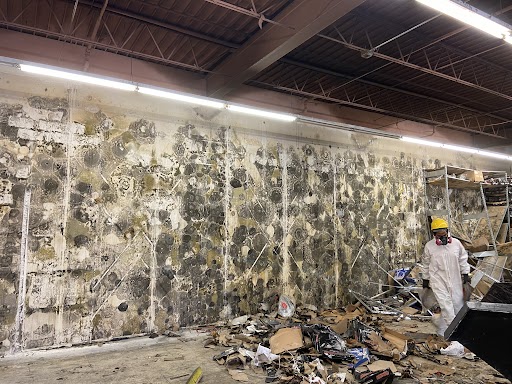When it comes to home cleaning, one of the things that can be as inconvenient as anything else is the growth of Mildew and Molds. These fungi are not only pesky when they appear in our homes, apartments, and offices, but they can also be dangerous to health. Although some people don’t differentiate between mildew and mold, it is important to know the differences to prevent and control the two. They are both moisture-loving mushrooms; however, their features and consequences vary greatly.
In this blog, we will focus on the main differences between mildew and mold: main characteristics, conditions for development, and their effects on health. Explore this blog to find out the true nature of these two mistaken enemies!
What is Mildew?
Mildew is a fungus that grows flat, powdery, and usually comes in white or gray correlations. Mold loves warm areas and humidity and is often found in washrooms, kitchens, and materials hung to dry. Mildew mostly occurs on surfaces such as wood, paper, and textiles in the form of blots and produces an offensive fungi smell.
For example, if you have shower curtains that you left wet and did not dry properly, the curtains will develop mildew, be an eye soar, and attract more such molds.
What is Mold?
Molds are a more advanced form of fungi and often come in various colors: green, black, and sometimes orange or purple. Mold is generally larger and can develop large patches; the mold can even soak through walls, carpets, and wood. Indoor and outdoor mold can grow in regions with steady amounts of moisture.
An example of mold is the nasty-looking black mold that may grow on the bathroom walls or corners, especially where water stains are common, which may also be a sign of further moisture issues. Mold is a problem and causes significant damage to structures if not mitigated.
Now you know the meaning of these two popular terms. They seem the same, but there is a very thin line, and certain points set these two terms apart.
Major Differences Between Mildew and Mold
There are several key differences that people should know about mold and mildew; the two terms are used interchangeably by most people, but there are some ways in which mold and mildew differ tremendously.
Appearance
Mildew is usually a powdery substance often seen as thin in appearance and ranges in color from white, gray, or yellow. Frequently, it is smooth and uniform in texture and may be confused with dirt or dust.
On the other hand, mold can be of different colours: green, black, blue, red, and so on; it normally has a fuzzy or hairy-like structure.
Location of Growth
Mildew is more likely to develop in warmer and humid conditions and regularly grows on bathroom tiles, shower curtains, or in the kitchen. This kind of bacteria generally develops in conditions whereby it secures the attachment to the organic matter, which is wet and has a low permeability.
On the other hand, mold has a wider host specificity; for example, it can grow on wood, drywall, and food. Mold is most commonly found growing in damp locations and can grow in areas not easily seen, such as behind walls and under carpets.
Health Effects
Besides, while mildew and molds can both be hazardous to health, they vary in how they affect the body. Mildew is less dangerous than its parent fungus but can cause some people allergic reactions and respiratory irritation.
Mold, especially black mold (Stachybotrys chartarum), may cause actual mycotoxins that may result in further adverse health effects than simple inflammation of the lungs; of course, if ingested, inhaled or touched, it may lead to chronic respiratory disorders, neurological disorders, and weakened immune systems.
Growth Rate
Mildew is slower-growing than mold most of the time. Mold mildew, on the other hand, usually takes days to weeks to evolve, yet mold grows within 24 to 48 hours under a conducive environment. This difference means mold breakouts can become severe, fast, and require immediate intervention.
Removal and Treatment
Meanwhile, mild grows are more straightforward and can be handled with simple solutions such as vinegar or bleach. It can be greatly prevented by cleanup and ensuring good airflow in the affected area.
On the other hand, mold may need some serious action to get rid of, such as hiring mold remediation professionals if the mold has spread or is already growing in the walls. It often requires the removal and replacement of affected material.
Health Effects: Mildew and Mold
Mold is damaging to health in that it is capable of respiratory illness or making existing respiratory conditions worse among persons suffering from the same or those with slightly compromised immune systems. mildew can aggravate the health conditions of asthmatic patients. However, exposure to mold leads to effects such as sneezing, coughing and throat irritation.
On the other hand, mold also tends to cause serious health complications, including chronic respiratory diseases and allergy problems. Some types of mold pose special threats even after the victim has been removed to a mold-free environment; black mold is perhaps one of the most dangerous molds that one can be exposed to.
Conclusion
It is important to know the differences between mildew and mold to ensure that a house has good air quality. Both of these pests are likely to be found in the living area, and to deal with the problem; it pays to seek professional help as soon as you notice signs of their presence to avoid any health hazards and property damage.
If you need professional mold remediation services in the best way, contact us as soon as possible! Our team is dedicated to restoring your living space and ensuring you and your family’s calmness.
Don’t let mildew turn into mold – take action with our professional remediation services today



